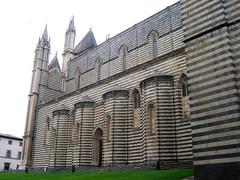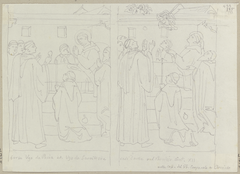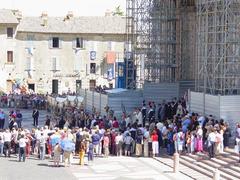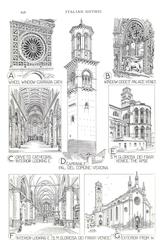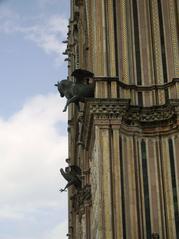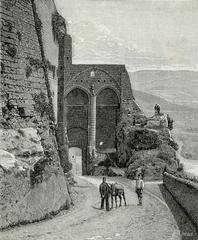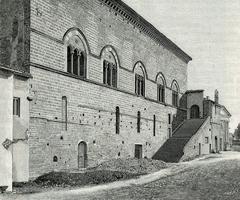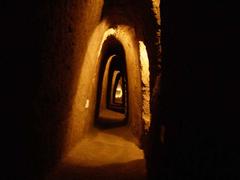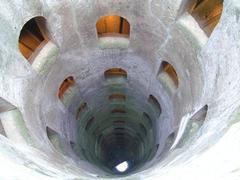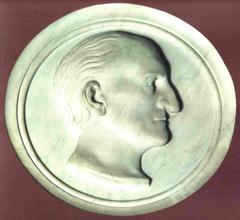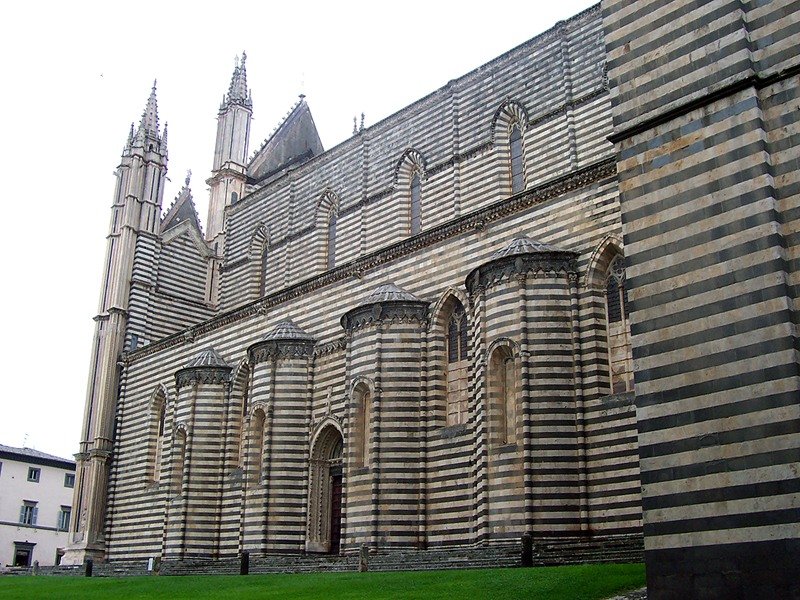
Visiting Orvieto Cathedral: Hours, Tickets, and Historical Insights
Publication Date: 16/08/2024
Introduction to Orvieto Cathedral
The Orvieto Cathedral, or Duomo di Orvieto, is a magnificent example of Italian Gothic architecture, situated in the picturesque town of Orvieto in Umbria, Italy. Commissioned in 1290 by Pope Nicholas IV, the cathedral is deeply intertwined with historical, religious, and cultural narratives, particularly the Miracle of Bolsena. This miraculous event, where a consecrated host allegedly bled during Mass, inspired the construction of this monumental cathedral to house the relics associated with the miracle (Pilgrim Info). Designed by prominent architects such as Fra Bevignate di Perugia and Lorenzo Maitani, the cathedral showcases a stunning façade adorned with golden mosaics, bas-reliefs, and statues that reflect the evolving architectural styles from Romanesque to Gothic (Wikipedia). Inside, visitors are greeted with awe-inspiring frescoes by renowned artists like Luca Signorelli and Fra Angelico, making the cathedral not just a place of worship but a treasure trove of Renaissance art (Britannica). This guide aims to provide a comprehensive overview of the cathedral’s history, architectural significance, and practical visitor information, including visiting hours, ticket prices, and travel tips, to ensure an enriching and unforgettable experience.
Contents Overview
- Introduction
- History of Orvieto Cathedral
- Origins and Initial Construction
- The Miracle of Bolsena
- Architectural Evolution
- Political and Social Context
- Contributions of Artists and Craftsmen
- Interior Highlights
- The Chapel of the Corporal
- The Chapel of San Brizio
- Restoration and Preservation
- Visitor Information
- Visiting Hours and Tickets
- Travel Tips and Accessibility
- FAQ Section
- Conclusion
Exploring the Orvieto Cathedral: History, Visiting Hours, and Tickets
Introduction
The Orvieto Cathedral, also known as the Duomo di Orvieto, is a monumental structure that stands as a testament to the religious, political, and artistic fervor of medieval Italy. This guide will delve into its rich history, stunning architectural details, and provide essential visitor information including visiting hours, ticket prices, and travel tips to make your visit unforgettable.
History of Orvieto Cathedral
Origins and Initial Construction
The Orvieto Cathedral’s construction began on November 13, 1290, under the orders of Pope Nicholas IV. The initial design was entrusted to the chief mason Fra Bevignate di Perugia, who utilized a plan by Arnolfo di Cambio, the architect of the Florence Cathedral (Wikipedia). The cathedral was initially conceived as a Romanesque basilica with a nave and two side aisles. However, when Giovanni di Uguccione succeeded Fra Bevignate, the design evolved into Italian Gothic forms, reflecting the changing architectural tastes of the period (Wikipedia).
The Miracle of Bolsena
One of the key events that spurred the construction of the Orvieto Cathedral was the Miracle of Bolsena, which occurred in 1263. According to tradition, a Bohemian priest who doubted the doctrine of transubstantiation witnessed the consecrated host bleeding during a Mass at the Basilica of Saint Christina in Bolsena. This miraculous event was seen as divine proof of the doctrine and led Pope Urban IV to commission the construction of the cathedral to house the relic (Pilgrim Info).
Architectural Evolution
The construction of the Orvieto Cathedral spanned several centuries, from the 13th to the 17th century, with significant additions and modifications made even in the 20th century. The façade, a masterpiece of Gothic architecture, was designed by Lorenzo Maitani, who was influenced by the Tuscan Gothic style of the Siena Cathedral by Giovanni Pisano and the Florence Cathedral by Arnolfo di Cambio (Wikipedia). The façade is adorned with golden mosaics, large bas-reliefs, and statues representing the symbols of the Evangelists—Angel, Ox, Lion, and Eagle. These elements were created by Maitani and his collaborators between 1325 and 1330. In 1352, Matteo di Ugolino da Bologna added the bronze Lamb of God above the central gable and the bronze statue of Saint Michael on top of the left entrance gable (Wikipedia).
Political and Social Context
The construction of the Orvieto Cathedral was not solely a religious endeavor; it was also influenced by political, social, and artistic factors. At the end of the 13th century, Orvieto was a powerful town with a developed political and institutional structure. The town was experiencing a period of civil and economic development, coupled with a great religious fervor, partly due to the Miracle of Bolsena and the issuance of the “Transiturus de hoc mundo” Papal Bull by Pope Urban IV in 1264. This bull established the Corpus Domini festivity, which aimed to counter various heresies and promote the doctrine of transubstantiation (Pilgrim Info).
Contributions of Artists and Craftsmen
The construction of the Orvieto Cathedral was a collaborative effort involving numerous artists, craftsmen, and workers. Lorenzo Maitani, the chief architect, played a pivotal role in shaping the cathedral’s design and decorations. After Maitani, many other architects and artists from all over Italy contributed to the project over the following centuries. The façade’s mosaic decorations, primarily depicting scenes from the life of the Virgin Mary, were designed by Ugolino di Prete Ilario and executed by Brother Giovanni Leonardelli in the second half of the 14th century (Secret Umbria).
Interior Highlights
The interior of the Orvieto Cathedral is equally impressive, featuring three naves covered by wood trusses and decorated with bands of travertine and basalt. The space is reminiscent of ancient Roman basilicas and is made solemn by the vertical dynamics of the walls, central pillars, and light effects from alabaster windows (Secret Umbria).
The Chapel of the Corporal
One of the most significant interior features is the Chapel of the Corporal, which houses the relic of the Holy Corporal stained by the blood of the consecrated host during the Miracle of Bolsena. The chapel’s walls are adorned with frescoes by Ugolino di Prete Ilario, created between 1357 and 1364, depicting the story of the miracle. The chapel also contains a precious reliquary made by the goldsmith Ugolino di Vieri in 1337 (Secret Umbria).
The Chapel of San Brizio
Another highlight is the Chapel of San Brizio, which features some of the most remarkable examples of 15th-century Italian painting. The vault was frescoed by Fra Angelico between 1447 and 1449, while the walls were completed by Luca Signorelli between 1449 and 1504. The frescoes depict scenes from the Last Judgment and are considered masterpieces of Renaissance art (Secret Umbria).
Restoration and Preservation
The Orvieto Cathedral has undergone several restoration efforts over the centuries to preserve its architectural and artistic integrity. The façade and exterior were heavily restored in the 19th century, while the interior has been partially restored but remains mostly intact. The main chapels, including the Chapel of the Corporal and the Chapel of San Brizio, have largely retained their original decorations (Humana Lens).
Visitor Information
Visiting Hours and Tickets
The Orvieto Cathedral is open year-round, with varying hours depending on the season. It is advisable to check the official website for the most up-to-date visiting hours. Tickets can be purchased online or at the entrance. Prices vary, with discounts available for children, students, and seniors. A single ticket grants access to multiple venues, including the cathedral, the Museo dell’Opera del Duomo, the Museo Emilio Greco, and the Orvieto Underground (Humana Lens).
Travel Tips and Accessibility
For those planning a visit, it is advisable to purchase tickets in advance, especially during the high season, to avoid long queues. The cathedral is accessible to visitors with reduced mobility, and it offers a profound experience for all ages, although it is recommended to keep visits brief for families with young children. Nearby attractions include the Pozzo di San Patrizio and the Torre del Moro, which offer additional insights into the region’s rich history (Humana Lens).
FAQ Section
What are the opening hours of Orvieto Cathedral?
The Orvieto Cathedral is open year-round, with varying hours depending on the season. Please check the official website for the most up-to-date information.
How much are the tickets for Orvieto Cathedral?
Ticket prices vary, with discounts available for children, students, and seniors. A single ticket grants access to multiple venues, including the cathedral and several museums. Purchasing tickets in advance is recommended.
Is Orvieto Cathedral accessible to visitors with disabilities?
Yes, the Orvieto Cathedral is accessible to visitors with reduced mobility.
Conclusion
In summary, the Orvieto Cathedral stands as a monumental achievement of medieval architecture and art, deeply rooted in the religious, political, and social fabric of its time. Its rich history, coupled with its stunning artistic and architectural features, makes it a must-visit destination for anyone exploring the region of Umbria. To stay updated on more travel tips and historical insights, follow us on social media or check out our other related posts.
